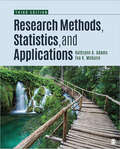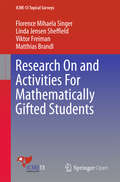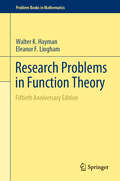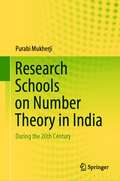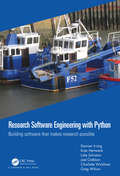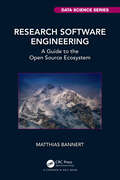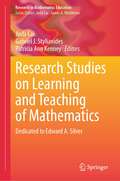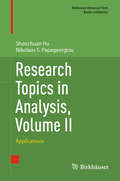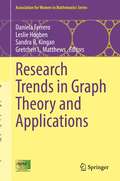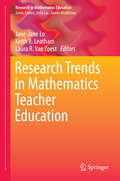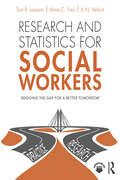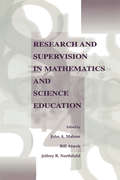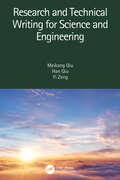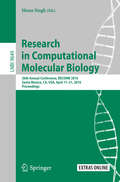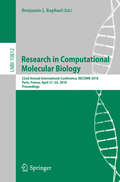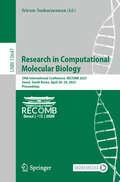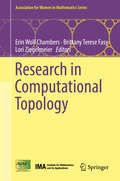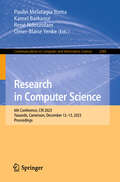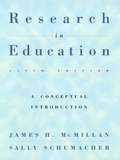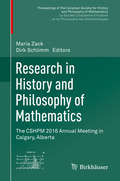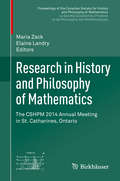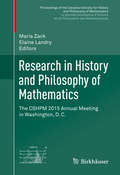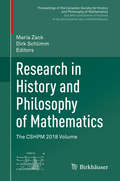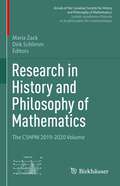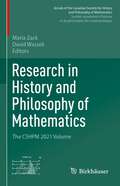- Table View
- List View
Research Methods, Statistics, and Applications
by Kathrynn A. Adams Eva Kung McGuire (aka: Lawrence)Research Methods, Statistics, and Applications by Kathrynn A. Adams and Eva K. McGuire is designed to give students the experience of being a researcher by combining the interrelated concepts of research methods and statistics to better explain how the research process incorporates both elements. Employing a conversational tone throughout, coupled with an emphasis on decision-making, this best-selling text will spark students’ interest in conducting research and improve their ability to critically analyze research in their daily lives. The Third Edition includes a new chapter on measurement to better highlight its critical importance, updates for the 7th edition of the Publication Manual of the American Psychological Association, new examples related to social justice, additional sections on qualitative research methods, and more thorough integration of research ethics information and tips throughout each chapter.
Research On and Activities For Mathematically Gifted Students (ICME-13 Monographs)
by Linda Jensen Sheffield Florence Mihaela Singer Viktor Freiman Matthias BrandlThis Topical Survey offers a brief overview of the current state of research on and activities for mathematically gifted students around the world. This is of interest to a broad readership, including educational researchers, research mathematicians, mathematics teachers, teacher educators, curriculum designers, doctoral students, and other stakeholders. It first discusses research concerning the nature of mathematical giftedness, including theoretical frameworks and methodologies that are helpful in identifying and/or creating mathematically gifted students, which is described in this section. It also focuses on research on and the development of mathematical talent and innovation in students, including connections between cognitive, social and affective aspects of mathematically gifted students. Exemplary teaching and learning practices, curricula and a variety of programs that contribute to the development of mathematical talent, gifts, and passion are described as well as the pedagogy and mathematics content suitable for educating pre-service and in-service teachers of mathematically gifted students. The final section provides a brief summary of the paper along with suggestions for the research, activities, and resources that should be available to support mathematically gifted students and their teachers, parents, and other stakeholders.
Research Problems in Function Theory: Fiftieth Anniversary Edition (Problem Books in Mathematics)
by Walter K. Hayman Eleanor F. LinghamIn 1967 Walter K. Hayman published ‘Research Problems in Function Theory’, a list of 141 problems in seven areas of function theory. In the decades following, this list was extended to include two additional areas of complex analysis, updates on progress in solving existing problems, and over 520 research problems from mathematicians worldwide. It became known as ‘Hayman's List’. This Fiftieth Anniversary Edition contains the complete ‘Hayman's List’ for the first time in book form, along with 31 new problems by leading international mathematicians. This list has directed complex analysis research for the last half-century, and the new edition will help guide future research in the subject. The book contains up-to-date information on each problem, gathered from the international mathematics community, and where possible suggests directions for further investigation. Aimed at both early career and established researchers, this book provides the key problems and results needed to progress in the most important research questions in complex analysis, and documents the developments of the past 50 years.
Research Schools on Number Theory in India: During the 20th Century
by Purabi MukherjiThis book is an attempt to describe the gradual development of the major schools of research on number theory in South India, Punjab, Mumbai, Bengal, and Bihar—including the establishment of Tata Institute of Fundamental Research (TIFR), Mumbai, a landmark event in the history of research of number theory in India. Research on number theory in India during modern times started with the advent of the iconic genius Srinivasa Ramanujan, inspiring mathematicians around the world. This book discusses the national and international impact of the research made by Indian number theorists. It also includes a carefully compiled, comprehensive bibliography of major 20th century Indian number theorists making this book important from the standpoint of historic documentation and a valuable resource for researchers of the field for their literature survey. This book also briefly discusses the importance of number theory in the modern world of mathematics, including applications of the results developed by indigenous number theorists in practical fields. Since the book is written from the viewpoint of the history of science, technical jargon and mathematical expressions have been avoided as much as possible.
Research Software Engineering with Python: Building software that makes research possible
by Greg Wilson Damien Irving Kate Hertweck Luke Johnston Joel Ostblom Charlotte WickhamWriting and running software is now as much a part of science as telescopes and test tubes, but most researchers are never taught how to do either well. As a result, it takes them longer to accomplish simple tasks than it should, and it is harder for them to share their work with others than it needs to be. This book introduces the concepts, tools, and skills that researchers need to get more done in less time and with less pain. Based on the practical experiences of its authors, who collectively have spent several decades teaching software skills to scientists, it covers everything graduate-level researchers need to automate their workflows, collaborate with colleagues, ensure that their results are trustworthy, and publish what they have built so that others can build on it. The book assumes only a basic knowledge of Python as a starting point, and shows readers how it, the Unix shell, Git, Make, and related tools can give them more time to focus on the research they actually want to do. Research Software Engineering with Python can be used as the main text in a one-semester course or for self-guided study. A running example shows how to organize a small research project step by step; over a hundred exercises give readers a chance to practice these skills themselves, while a glossary defining over two hundred terms will help readers find their way through the terminology. All of the material can be re-used under a Creative Commons license, and all royalties from sales of the book will be donated to The Carpentries, an organization that teaches foundational coding and data science skills to researchers worldwide.
Research Software Engineering: A Guide to the Open Source Ecosystem (Chapman & Hall/CRC Data Science Series)
by Matthias BannertResearch Software Engineering: A Guide to the Open Source Ecosystem strives to give a big-picture overview and an understanding of the opportunities of programming as an approach to analytics and statistics. The book argues that a solid "programming" skill level is not only well within reach for many but also worth pursuing for researchers and business analysts. The ability to write a program leverages field-specific expertise and fosters interdisciplinary collaboration as source code continues to become an important communication channel. Given the pace of the development in data science, many senior researchers and mentors, alongside non-computer science curricula lack a basic software engineering component. This book fills the gap by providing a dedicated programming-with-data resource to both academic scholars and practitioners.Key Features overview: breakdown of complex data science software stacks into core components applied: source code of figures, tables and examples available and reproducible solely with license cost-free, open source software reader guidance: different entry points and rich references to deepen the understanding of selected aspects
Research Studies on Learning and Teaching of Mathematics: Dedicated to Edward A. Silver (Research in Mathematics Education)
by Jinfa Cai Gabriel J. Stylianides Patricia Ann KenneyThis book is about promising research advancements that sparked directly or indirectly from intellectual contributions by distinguished internationally recognized mathematics educator and researcher, Edward A. Silver. The features of this book include:A focus on the research areas that have benefited from Dr. Silver’s intellectual contributions and influence, such as designing instructional tasks, problem posing, problem solving, preservice teacher learning, in service teacher professional development, and mathematics assessmentChapters written by contributors who at one time were his doctoral or post-doctoral colleagues along with any invited co-authorsA brief bio of Dr. Silver showing his intellectual journey, key milestones in his career, and scholarly accomplishments that sparked from his intellectual contributions
Research Topics in Analysis, Volume II: Applications (Birkhäuser Advanced Texts Basler Lehrbücher)
by Nikolaos S. Papageorgiou Shouchuan HuThis book, the second of two volumes, presents significant applications for understanding modern analysis. It empowers young researchers with key techniques and applications to explore various subfields of this broad subject and introduces relevant frameworks for immediate deployment. The applications list begins with Degree Theory, a useful tool for studying nonlinear equations. Chapter 2 deals with Fixed Point Theory, and Chapter 3 introduces Critical Point Theory. Chapter 4 presents the main spectral properties of linear, nonlinear, anisotropic, and double-phase differential operators. Chapter 5 covers semilinear and nonlinear elliptic equations with different boundary conditions, while Chapter 6 addresses dynamic systems monitored by ordinary and partial differential equations. Chapter 7 delves into optimal control problems, and Chapter 8 discusses some economic models, providing a brief presentation of Game Theory and Nash equilibrium. By offering a clear and comprehensive overview of modern analysis tools and applications, this work can greatly benefit mature graduate students seeking research topics, as well as experienced researchers interested in this vast and rich field of mathematics.
Research Trends in Graph Theory and Applications (Association for Women in Mathematics Series #25)
by Leslie Hogben Daniela Ferrero Sandra R. Kingan Gretchen L. MatthewsThe Workshop for Women in Graph Theory and Applications was held at the Institute for Mathematics and Its Applications (University of Minnesota, Minneapolis) on August 19-23, 2019. During this five-day workshop, 42 participants performed collaborative research, in six teams, each focused on open problems in different areas of graph theory and its applications. The research work of each team was led by two experts in the corresponding area, who prior to the workshop, carefully selected relevant and meaningful open problems that would yield high-quality research and results of strong impact. As a result, all six teams have made significant contributions to several open problems in their respective areas. The workshop led to the creation of the Women in Graph Theory and Applications Research Collaboration Network, which provided the framework to continue collaborating and to produce this volume.This book contains six chapters, each of them on one of the different areas of research at the Workshop for Women in Graph Theory and Applications, and written by participants of each team.
Research Trends in Mathematics Teacher Education
by Jane-Jane Lo Keith R. Leatham Laura R. Van ZoestResearch on the preparation and continued development of mathematics teachers is becoming an increasingly important subset of mathematics education research. Such research explores the attributes, knowledge, skills and beliefs of mathematics teachers as well as methods for assessing and developing these critical aspects of teachers and influences on teaching. Research Trends in Mathematics Teacher Education focuses on three major themes in current mathematics teacher education research: mathematical knowledge for teaching, teacher beliefs and identities, and tools and techniques to support teacher learning. Through careful reports of individual research studies and cross-study syntheses of the state of research in these areas, the book provides insights into teachers' learning processes and how these processes can be harnessed to develop effective teachers. Chapters investigate bedrock skills needed for working with primary and secondary learners (writing relevant problems, planning lessons, being attentive to student learning) and illustrate how knowledge can be accessed, assessed, and nurtured over the course of a teaching career. Commentaries provide context for current research while identifying areas deserving future study. Included among the topics: Teachers' curricular knowledge Teachers' personal and classroom mathematics Teachers' learning journeys toward reasoning and sense-making Teachers' transitions in noticing Teachers' uses of a learning trajectory as a tool for mathematics lesson planning A unique and timely set of perspectives on the professional development of mathematics teachers at all stages of their careers, Research Trends in Mathematics Teacher Education brings clarity and practical advice to researchers as well as practitioners in this increasingly critical arena
Research and Statistics for Social Workers
by Tom Lawson Anna Faul A. N. VerbistUsing real social work examples written specifically to ally student fears Research and Statistics for Social Workers brings research and statistics together bridging the gap to practice. This book covers - conceptualization, ethics, cultural competence, design, qualitative research, individual and program evaluation as well as nonparametric and parametric statistical tests. The tests are explained narratively, mathematically as well as with a comprehensive step-by-step, fully illustrated SPSS computer analysis of social work data.
Research and Supervision in Mathematics and Science Education
by Bill Atweh John A. Malone Jeffrey R. NorthfieldResearch and Supervision in Mathematics and Science Education provides student researchers and their supervisors with information about both the essentials of planning, conducting, reporting, and publishing qualitative research, and the characteristics of quality supervision. It is focused primarily for postgraduate research students in mathematics and science education and their supervisors. It will also be of interest to students and faculty in other disciplines that use educational and sociological research paradigms. The volume builds on two phenomena of recent years: first, the increasing momentum of postgraduate research in mathematics and science education and, second, the resulting need of those involved for knowledge about doing research and about engaging in quality supervision. The decision to address both research and supervision in one volume is a response to the fact that faculty who supervise postgraduate research often are in need of resources covering not only aspects of project and thesis supervision, but also the knowledge to assist students in research design, especially in the qualitative field. Drawing on recent research and practice, the authors of the chapters in this book illustrate approaches and strategies that have been used successfully with, and by, postgraduate students. The book also has a strong future orientation, describing how postgraduate supervision and research will change as more and more students gain access to and make use of the vast array of technological resources now available. A necessary and unique addition to books in the field of postgraduate research and supervision, this volume's particular appeal stems from its practical approach, its creative future perspective, and the wide generalizability of the thinking and ideas it presents.
Research and Technical Writing for Science and Engineering
by Yi Zeng Meikang Qiu Han QiuEngineering and science research can be difficult for beginners because scientific research is fraught with constraints and disciplines. Research and Technical Writing for Science and Engineering breakdowns the entire process of conducting engineering and scientific research. This book covers those fascinating guidelines and topics on conducting research, as well as how to better interact with your advisor. Key Features: advice on conducting a literature review, conducting experiments, and writing a good paper summarizing your findings. provides a tutorial on how to increase the impact of research and how to manage research resources. By reflecting on the cases discussed in this book, readers will be able to identify specific situations or dilemmas in their own lives, as the authors provide comprehensive suggestions based on their own experiences.
Research in Computational Molecular Biology
by Mona SinghThisbook constitutes the proceedings of the 20th Annual Conference on Research inComputational Molecular Biology, RECOMB 2016, held in Santa Monica, CA, USA, inApril 2016. The 15 regular papers presented in this volume were carefullyreviewed and selected from 172 submissions. 20 short abstracts are included inthe back matter of the volume. They report on original research in all areas ofcomputational molecular biology and bioinformatics.
Research in Computational Molecular Biology: 22nd Annual International Conference, RECOMB 2018, Paris, France, April 21-24, 2018, Proceedings (Lecture Notes in Computer Science #10812)
by Benjamin J. RaphaelThis book constitutes the proceedings of the 22nd Annual Conference on Research in Computational Molecular Biology, RECOMB 2018, held in Paris, France, in April 2018.The 16 extended and 22 short abstracts presented were carefully reviewed and selected from 193 submissions. The short abstracts are included in the back matter of the volume. They report on original research in all areas of computational molecular biology and bioinformatics.
Research in Computational Molecular Biology: 29th International Conference, RECOMB 2025, Seoul, South Korea, April 26–29, 2025, Proceedings (Lecture Notes in Computer Science #15647)
by Sriram SankararamanThis book constitutes the proceedings of the 29th Annual International Conference on Research in Computational Molecular Biology, RECOMB 2025, held in Seoul, South Korea, during April 26–29, 2025. The 14 full papers and 41 short papers were carefully reviewed and selected from 339 submissions. They focus on advances in computational biology and applications in molecular biology and medicine. The conference aims at bridging the computational, mathematical, statistical, and biological sciences, and bringing together researchers, professionals, students and industrial practitioners from all over the world for interaction and exchange of new developments in all areas of bioinformatics and computational biology.
Research in Computational Topology (Association for Women in Mathematics Series #13)
by Erin Wolf Chambers Brittany Terese Fasy Lori ZiegelmeierBased on the first Workshop for Women in Computational Topology that took place in 2016, this volume assembles new research and applications in computational topology. Featured articles range over the breadth of the discipline, including topics such as surface reconstruction, topological data analysis, persistent homology, algorithms, and surface-embedded graphs. Applications in graphics, medical imaging, and GIS are discussed throughout the book. Four of the papers in this volume are the product of working groups that were established and developed during the workshop. Additional papers were also solicited from the broader Women in Computational Topology network. The volume is accessible to a broad range of researchers, both within the field of computational topology and in related disciplines such as statistics, computational biology, and machine learning.
Research in Computer Science: 6th Conference, CRI 2023, Yaounde, Cameroon, December 12–13, 2023, Proceedings (Communications in Computer and Information Science #2085)
by Kamel Barkaoui Paulin Melatagia Yonta René Ndoundam Omer-Blaise YenkeThis book constitutes the refereed proceedings of the 6th Conference on Research in Computer Science, CRI 2023, held in Yaounde, Cameroon, during December 12-13, 2023. The 16 full papers included in this book were carefully reviewed and selected from 72 submissions. The CRI 2023 proceedings focus on artificial intelligence, machine learning, natural language processing, computer vision, cryptography and distributed computing.
Research in Education: A Conceptual Introduction (5th edition)
by James H. Mcmillan Sally Schumacherpresents a comprehensive, yet relatively nontechnical, introduction to the principles, concepts, and methods currently used in educational research
Research in History and Philosophy of Mathematics
by Maria Zack Dirk SchlimmThis volume contains seventeen papers that were presented at the 2015 Annual Meeting of the Canadian Society for History and Philosophy of Mathematics/La Soci#65533;t#65533; Canadienne d'Histoire et de Philosophie des Math#65533;matiques, held in Washington, D. C. In addition to showcasing rigorously reviewed modern scholarship on an interesting variety of general topics in the history and philosophy of mathematics, this meeting also honored the memories of Jacqueline (Jackie) Stedall and Ivor Grattan-Guinness; celebrated the Centennial of the Mathematical Association of America; and considered the importance of mathematical communities in a special session. These themes and many others are explored in these collected papers, which cover subjects such as New evidence that the Latin translation of Euclid's Elements was based on the Arabic version attributed to al-Ḥajjāj Work done on the arc rampant in the seventeenth century The history of numerical methods for finding roots of nonlinear equations An original play featuring a dialogue between George Boole and Augustus De Morgan that explores the relationship between them Key issues in the digital preservation of mathematical material for future generations A look at the first twenty-five years of The American Mathematical Monthly in the context of the evolving American mathematical community The growth of Math Circles and the unique ways they are being implemented in the United States Written by leading scholars in the field, these papers will be accessible to not only mathematicians and students of the history and philosophy of mathematics, but also anyone with a general interest in mathematics.
Research in History and Philosophy of Mathematics
by Elaine Landry Maria ZackThis volume contains thirteen papers that were presented at the 2014 Annual Meeting of the Canadian Society for History and Philosophy of Mathematics/La Société Canadienne d'Histoire et de Philosophie des Mathématiques, held on the campus of Brock University in St. Catharines, Ontario, Canada. It contains rigorously reviewed modern scholarship on general topics in the history and philosophy of mathematics, as well as on the meeting's special topic, Early Scientific Computation. These papers cover subjects such as *Physical tools used by mathematicians in the seventeenth century *The first historical appearance of the game-theoretical concept of mixed-strategy equilibrium *George Washington's mathematical cyphering books *The development of the Venn diagram *The role of Euler and other mathematicians in the development of algebraic analysis *Arthur Cayley and Alfred Kempe's influence on Charles Peirce's diagrammatic logic *The influence publishers had on the development of mathematical pedagogy in the nineteenth century *A description of the 1924 International Mathematical Congress held in Toronto, told in the form of a "narrated slide show" Written by leading scholars in the field, these papers will be accessible to not only mathematicians and students of the history and philosophy of mathematics, but also anyone with a general interest in mathematics.
Research in History and Philosophy of Mathematics
by Elaine Landry Maria ZackThis volume contains seventeen papers that were presented at the 2015 Annual Meeting of the Canadian Society for History and Philosophy of Mathematics/La Soci#65533;t#65533; Canadienne d'Histoire et de Philosophie des Math#65533;matiques, held in Washington, D. C. In addition to showcasing rigorously reviewed modern scholarship on an interesting variety of general topics in the history and philosophy of mathematics, this meeting also honored the memories of Jacqueline (Jackie) Stedall and Ivor Grattan-Guinness; celebrated the Centennial of the Mathematical Association of America; and considered the importance of mathematical communities in a special session. These themes and many others are explored in these collected papers, which cover subjects such as New evidence that the Latin translation of Euclid's Elements was based on the Arabic version attributed to al-Ḥajjāj Work done on the arc rampant in the seventeenth century The history of numerical methods for finding roots of nonlinear equations An original play featuring a dialogue between George Boole and Augustus De Morgan that explores the relationship between them Key issues in the digital preservation of mathematical material for future generations A look at the first twenty-five years of The American Mathematical Monthly in the context of the evolving American mathematical community The growth of Math Circles and the unique ways they are being implemented in the United States Written by leading scholars in the field, these papers will be accessible to not only mathematicians and students of the history and philosophy of mathematics, but also anyone with a general interest in mathematics.
Research in History and Philosophy of Mathematics: The CSHPM 2018 Volume (Proceedings of the Canadian Society for History and Philosophy of Mathematics/ Société canadienne d’histoire et de philosophie des mathématiques)
by Maria Zack Dirk SchlimmThis volume contains ten papers that have been collected by the Canadian Society for History and Philosophy of Mathematics/Société canadienne d’histoire et de philosophie des mathématiques. It showcases rigorously-reviewed contemporary scholarship on an interesting variety of topics in the history and philosophy of mathematics from the seventeenth century to the modern era.The volume begins with an exposition of the life and work of Professor Bolesław Sobociński. It then moves on to cover a collection of topics about twentieth-century philosophy of mathematics, including Fred Sommers’s creation of Traditional Formal Logic and Alexander Grothendieck’s work as a starting point for discussing analogies between commutative algebra and algebraic geometry. Continuing the focus on the philosophy of mathematics, the next selections discuss the mathematization of biology and address the study of numerical cognition. The volume then moves to discussing various aspects of mathematics education, including Charles Davies’s early book on the teaching of mathematics and the use of Gaussian Lemniscates in the classroom. A collection of papers on the history of mathematics in the nineteenth century closes out the volume, presenting a discussion of Gauss’s “Allgemeine Theorie des Erdmagnetismus” and a comparison of the geometric works of Desargues and La Hire. Written by leading scholars in the field, these papers are accessible not only to mathematicians and students of the history and philosophy of mathematics, but also to anyone with a general interest in mathematics.
Research in History and Philosophy of Mathematics: The CSHPM 2019-2020 Volume (Annals of the Canadian Society for History and Philosophy of Mathematics/ Société canadienne d’histoire et de philosophie des mathématiques)
by Maria Zack Dirk SchlimmThis volume contains eleven papers that have been collected by the Canadian Society for History and Philosophy of Mathematics/Société canadienne d’histoire et de philosophie des mathématiques. It showcases rigorously-reviewed contemporary scholarship on an interesting variety of topics in the history and philosophy of mathematics, as well as the teaching of the history of mathematics. Topics considered includeThe mathematics and astronomy in Nathaniel Torperly’s only published work, Diclides Coelometricae, seu valvae astronomicae universalConnections between the work of Urbain Le Verrier, Carl Gustav Jacob Jacobi, and Augustin-Louis Cauchy on the algebraic eigenvalue problemAn evaluation of Ken Manders’ argument against conceiving of the diagrams in Euclid’s Elements in semantic termsThe development of undergraduate modern algebra courses in the United StatesWays of using the history of mathematics to teach the foundations of mathematical analysisWritten by leading scholars in the field, these papers are accessible not only to mathematicians and students of the history and philosophy of mathematics, but also to anyone with a general interest in mathematics.
Research in History and Philosophy of Mathematics: The CSHPM 2021 Volume (Annals of the Canadian Society for History and Philosophy of Mathematics/ Société canadienne d’histoire et de philosophie des mathématiques)
by Maria Zack David WaszekThis volume contains eighteen papers that have been collected by the Canadian Society for History and Philosophy of Mathematics. It showcases rigorously-reviewed contemporary scholarship on an interesting variety of topics in the history and philosophy of mathematics, as well as the teaching of the history of mathematics. Some of the topics explored includeArabic editions of Euclid’s Elements from the thirteenth century and their role in the assimilation of Euclidean geometry into the Islamic intellectual traditionPortuguese sixteenth century recreational mathematics as found in the Tratado de Prática Darysmetica A Cambridge correspondence course in arithmetic for women in England in the late nineteenth centuryThe mathematical interests of the famous Egyptologist Thomas Eric (T. E.) Peet The history of Zentralblatt für Mathematik and Mathematical Reviews and their role in creating a publishing infrastructure for a global mathematical literatureThe use of Latin squares for agricultural crop experiments at the Rothamsted Experimental StationThe many contributions of women to the advancement of computing techniques at the Cavendish Laboratory at the University of Cambridge in the 1960sThe volume concludes with two short plays, one set in Ancient Mesopotamia and the other in Ancient Egypt, that are well suited for use in the mathematics classroom.Written by leading scholars in the field, these papers are accessible not only to mathematicians and students of the history and philosophy of mathematics, but also to anyone with a general interest in mathematics.
